Mountain Willow
(Salix arbuscula)
Mountain Willow (Salix arbuscula)
/
/

Agnieszka Kwiecień, Nova
CC BY-SA 4.0
Image By:
Agnieszka Kwiecień, Nova
Recorded By:
Copyright:
CC BY-SA 4.0
Copyright Notice:
Photo by: Agnieszka Kwiecień, Nova | License Type: CC BY-SA 4.0 | License URL: https://creativecommons.org/licenses/by-sa/4.0 | Uploader: Nova | Publisher: Wikipedia Commons












Estimated Native Range
Climate Requirements for Ridgecrest, California
| This Plant | Your Site | Plant Suitability for Your Location | ||
|---|---|---|---|---|
| • Precipitation | 8" - 117" | 3" | Your precipitation may be insufficient for this plant. Irrigate N" / year. | Irrigate N" / year |
| • High Temp. | 38°F - 76°F | 103°F | Your summers may be too hot for this plant. | Too hot |
| • Low Temp. | -44°F - 36°F | 32°F | Your winter temperatures are normal for this plant | Excellent |
This plant should grow well at your location with about N inches per year (Y minutes per month) of irrigation.
Summary
Salix arbuscula, commonly known as Mountain Willow, is a deciduous shrub native to the cold, mountainous regions of northern Scandinavia and eastwards to Siberia. In Scotland, it is specifically adapted to high-altitude environments, such as damp rocky mountain slopes and ledges, typically above 1,968 feet, with a notable presence in Perthshire and Argyll. It is a low, much-branched shrub that seldom exceeds 2.3 feet in height, with a similar spread, and thrives in the harsh conditions of its native alpine and subarctic habitats.
Mountain Willow is valued for its resilience to cold climates and its ability to stabilize soil in rocky areas. Its small stature and branching habit make it suitable for rock gardens and alpine garden settings. It prefers moist, well-drained soils and can tolerate partial shade, although it flourishes in full sun. While not widely cultivated, it can be an interesting addition to collections of cold-hardy plants. It is relatively low-maintenance but may require protection from strong winds due to its delicate branches.CC BY-SA 4.0
Mountain Willow is valued for its resilience to cold climates and its ability to stabilize soil in rocky areas. Its small stature and branching habit make it suitable for rock gardens and alpine garden settings. It prefers moist, well-drained soils and can tolerate partial shade, although it flourishes in full sun. While not widely cultivated, it can be an interesting addition to collections of cold-hardy plants. It is relatively low-maintenance but may require protection from strong winds due to its delicate branches.CC BY-SA 4.0
Plant Description
- Plant Type: Shrub
- Height: 1-2 feet
- Width: 1-2 feet
- Growth Rate: Moderate
- Flower Color: N/A
- Flowering Season: Spring
- Leaf Retention: Deciduous
Growth Requirements
- Sun: Full Sun
- Water: Medium
- Drainage: Medium
Common Uses
Erosion Control, Low Maintenance, Water Garden
Natural Habitat
Native to cold, mountainous regions of northern Scandinavia and eastwards to Siberia, specifically adapted to high-altitude environments such as damp rocky mountain slopes and ledges
Other Names
Common Names: Small-tree Willow
Scientific Names: Salix arbuscula, Salix alpestris, Salix alpestris, Salix arbuscula var. prunifolia, Salix carinata, Salix glauca, Salix glaucescens, Salix intermedia, Salix intermedia
GBIF Accepted Name: Salix arbuscula